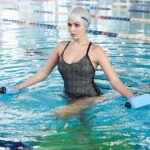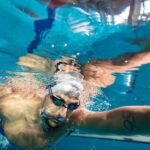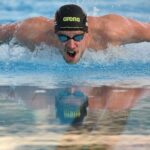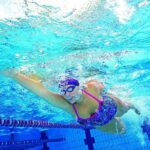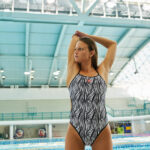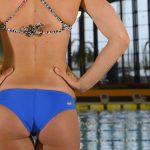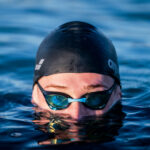Be fast without rushing – Part One
Butterfly & Breaststroke Turns
The turn plays an essential role in the stroke. If well performed, it can help you gain speed on each of the transitions and therefore help you acquire time. There are 2 types of turns: the flip turn in freestyle and backstroke, and the open turn in butterfly and breaststroke. It is important for young swimmers in their early years of training to learn how to control the various stages of the turn.
The different stages of the open turn (turn using the hands)
1. The approach
In order to achieve a fast turn, you need to arrive at the wall at a good speed. You have to work on your penultimate stroke cycle in order to gain speed during your last stroke cycle.

2. Hands on the wall
The head must remain streamlined with the entire body, with the hands gently absorbing the shock of the wall. Both hands must touch the wall at the same time.

3. The switchover
The legs have to be brought back quickly to the chest, heels at the buttock. One arm dives back in the water while the other one leaves the wall following push off. The head straightens out whereas the body and the legs remain in the same axis whilst rolling to the side. The switchover stage allows the feet to be positioned at the wall with the hands brought back out in front, an ideal time to breathe.

4. Diving though the water
The head dives through the water, with one leg coming up to the surface, hands positioned like an arrow. At this stage, the body should be entirely underwater, parallel to the surface.

5. The push off
Anchor the feet against the wall in a fluid movement, as the body positions and aligns itself parallel to the surface of the water. The push off should start just after the feet have made contact with the wall, and it should be progressive and explosive. When the push off ends and the underwater phase begins, your body should be repositioned (belly downwards) in a hydrodynamic position.

The various muscles
The main muscle groups stimulated in a turn are the pectoralis major and the triceps during the “hands on the wall” phase, all the muscles from the lap belt during the “switchover” phase, the gluteus maximus, the rectus femoris, the femoral biceps and the vastus lateralis muscle for the lower part of the body, which are used during the “wall push-off” phase .
Stay tuned to find out how you can improve your execution speed: second part coming soon!
—————
Are you looking for the ideal training swimsuit for your own specific needs? Take a look here!
Written by:
Nicolas Vannier
I am a master swimmer, who learnt to swim after being inspired by taking my own children to the pool. During my youth, I spent six years as a speed skater, and later went on to enjoy biking, running, skydiving and diving (PADI Divemaster). Swimming has really complemented my sporting career, I am completely hooked on it. I love the technique, stamina , motivation, speed, power and flexibility required for it. Having invested in Club Guingamp, I have now started to photograph and film its top swimmers, in order to create underwater exercise and technique videos, which allow others (under the technical advice of trainer Erwan Jacob) to progress in this wonderful sport.
